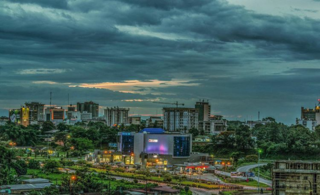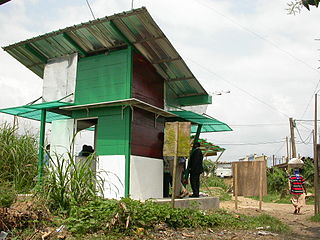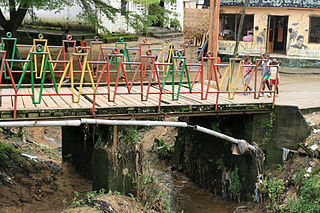| Bonakouamouang Chimney | |
|---|---|
 | |
| General information | |
| Type | industrial building, chimney |
| Architectural style | German colonial industrial architecture |
| Town or city | Douala |
| Country | Cameroon |
| Coordinates | 4°03′16″N9°42′24″E / 4.054416°N 9.706756°E |
| Completed | 19th century |
| Client | The German government |
The Bonakouamouang Chimney – situated in Douala, Cameroon in the district of Akwa neighborhood of Bessegue – is a relict of the waterworks built by the Germans at the beginning of the 19th century. The waterworks was part of the first phase of industrial investments aimed at the urbanisation of Kamerunstadt (Douala).

Douala is the largest city in Cameroon and its economic capital. It is also the capital of Cameroon's Littoral Region. Home to Central Africa's largest port and its major international airport, Douala International Airport (DLA), it is the commercial and economic capital of Cameroon and the entire CEMAC region comprising Gabon, Congo, Chad, Equatorial Guinea, Central African Republic and Cameroon. Consequently, it handles most of the country's major exports, such as oil, cocoa and coffee, timber, metals and fruits. As from 2018, the city and its surrounding area had an estimated population of 1,338,082. The city sits on the estuary of Wouri River and its climate is tropical.

Cameroon, officially the Republic of Cameroon, is a country in Central Africa. It is bordered by Nigeria to the west and north; Chad to the northeast; the Central African Republic to the east; and Equatorial Guinea, Gabon and the Republic of the Congo to the south. Cameroon's coastline lies on the Bight of Biafra, part of the Gulf of Guinea and the Atlantic Ocean. Although Cameroon is not an ECOWAS member state, it geographically and historically is in West Africa with the Southern Cameroons which now form her Northwest and Southwest Regions having a strong West African history. The country is sometimes identified as West African and other times as Central African due to its strategic position at the crossroads between West and Central Africa.
Contents
The supply of running water was necessary to allow the implementation of the major development works which would radically transform the traditional village of Douala into an urban agglomeration of administrative and commercial buildings, private residences, places of worship and schools. The urban plan of von Brautisch, head of Kamerunstadt district under the government of Jesko von Puttkamer (1895-1907), changed the local way of life and economy: wide streets were opened up, the Bonaku (Akwatown) marshes were drained, an embankment was built providing a route between Bonanjo and Akwa, the harbour area was expanded... henceforward denying fishermen any direct access to the river. The railway infrastructure created from the beginning of the 20th century was to develop communications with the country’s interior. Thus the Besséké valley became home to the first station on the town’s left bank, in the port area. From 1909 the Northern railway line was completed, linking Bonabéri and Nkongsamba. Work on the line joining Douala and Yaoundé began at the end of 1910-beginning of 1911.

Jesko Albert Eugen von Puttkamer was a German colonial military chief, and nine times governor of Kamerun:
Requisitioned as forced labour for these undertakings, the human cost of laying the foundations for the new colonial economy was a high one for the local workforce.

In 2006 the building is highlighted by an urban sign produced by doual'art and designed by Sandrine Dole; the sign presents an historical image of the building and a description of its history. [1]

doual'art is a non profit cultural organisation and art centre founded in 1991 in Douala, Cameroon and focussed on new urban practices of African cities.














